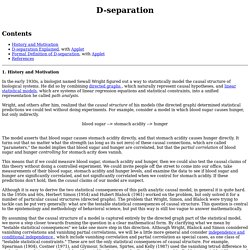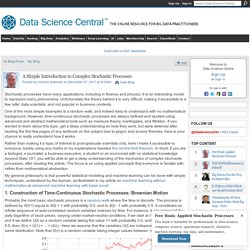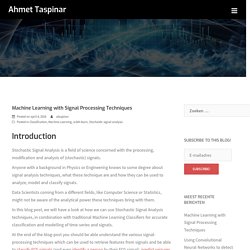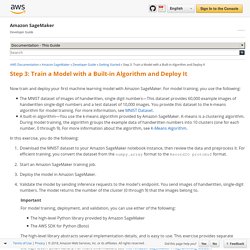

1701.00160. 5021 distributed representations of words and phrases and their compositionality. How to solve 90% of NLP problems: a step-by-step guide. Time series classification with Tensorflow. Time-series data arise in many fields including finance, signal processing, speech recognition and medicine.

A standard approach to time-series problems usually requires manual engineering of features which can then be fed into a machine learning algorithm. Engineering of features generally requires some domain knowledge of the discipline where the data has originated from. For example, if one is dealing with signals (i.e. classification of EEG signals), then possible features would involve power spectra at various frequency bands, Hjorth parameters and several other specialized statistical properties. Intuitively Understanding Variational Autoencoders. Google Docs - create and edit documents online, for free.
One account.

All of Google. Sign in to continue to Docs Find my account Forgot password? Pdf. ImageNet: VGGNet, ResNet, Inception, and Xception with Keras. D-separation. References Blalock, H.

(Ed.) (1971). Causal Models in the Social Sciences. A Simple Introduction to Complex Stochastic Processes. Stochastic processes have many applications, including in finance and physics.

It is an interesting model to represent many phenomena. Unfortunately the theory behind it is very difficult, making it accessible to a few 'elite' data scientists, and not popular in business contexts. One of the most simple examples is a random walk, and indeed easy to understand with no mathematical background. A Simple Introduction to Complex Stochastic Processes - Part 2. In my first article on this topic (see here) I introduced some of the complex stochastic processes used by Wall Street data scientists, using a simple approach that can be understood by people with no statistics background other than a first course such as stats 101.

I defined and illustrated the continuous Brownian motion (the mother of all these stochastic processes) using approximations by discrete random walks, simply re-scaling the X-axis and the Y-axis appropriately, and making time increments (the X-axis) smaller and smaller, so that the limiting process is a time-continuous one. This was done without using any complicated mathematics such as measure theory or filtrations. Here I am going one step further, introducing the integral and derivative of such processes, using rudimentary mathematics. Machine Learning with Signal Processing Techniques – Ahmet Taspinar. Introduction Stochastic Signal Analysis is a field of science concerned with the processing, modification and analysis of (stochastic) signals.

Anyone with a background in Physics or Engineering knows to some degree about signal analysis techniques, what these technique are and how they can be used to analyze, model and classify signals. Data Scientists coming from a different fields, like Computer Science or Statistics, might not be aware of the analytical power these techniques bring with them. How HBO’s Silicon Valley built “Not Hotdog” with mobile TensorFlow, Keras & React Native. 3.
The DeepDog Architecture. Principal-component-analysis-a-tutorial.pdf. Ng MLY03. Ng MLY02. Ng MLY01. Hierarchical_Variational_Autoencoders_for_Music.pdf. Time series classification with Tensorflow. Intuitively Understanding Variational Autoencoders. Step 3: Train a Model with a Built-in Algorithm and Deploy It - Amazon SageMaker. Now train and deploy your first machine learning model with Amazon SageMaker.

For model training, you use the following: The MNIST dataset of images of handwritten, single digit numbers—This dataset provides 60,000 example images of handwritten single-digit numbers and a test dataset of 10,000 images. You provide this dataset to the k-means algorithm for model training. For more information, see MNIST Dataset. Introducing TensorFlow Probability – TensorFlow. At the 2018 TensorFlow Developer Summit, we announced TensorFlow Probability: a probabilistic programming toolbox for machine learning researchers and practitioners to quickly and reliably build sophisticated models that leverage state-of-the-art hardware.

You should use TensorFlow Probability if: You want to build a generative model of data, reasoning about its hidden processes.You need to quantify the uncertainty in your predictions, as opposed to predicting a single value.Your training set has a large number of features relative to the number of data points.Your data is structured — for example, with groups, space, graphs, or language semantics — and you’d like to capture this structure with prior information.You have an inverse problem — see this TFDS’18 talk for reconstructing fusion plasmas from measurements.
TensorFlow Probability gives you the tools to solve these problems. MCMC tutorial. Markov Chain Monte Carlo for Computer Vision --- A tutorial at ICCV05 by Zhu, Delleart and Tu Markov chain Monte Carlo is a general computing technique that has been widely used in physics, chemistry, biology, statistics, and computer science.

It simulates a Markov chain whose invariant states follow a given (target) probability in a very high (say millions) dimensional state space. Essentially, it generates fair samples from a probability which are used for many purposes.A. System simulation. For many systems, their states are thought to follow some probability models. e.g. in statistical physics, the microscopic states of a system follows a Gibbs model given the macroscopic constraints.
Unsupervised Feature Learning and Deep Learning Tutorial. Problem Formulation As a refresher, we will start by learning how to implement linear regression. The main idea is to get familiar with objective functions, computing their gradients and optimizing the objectives over a set of parameters. These basic tools will form the basis for more sophisticated algorithms later. Leading the New Era of Machine Intelligence. Based on a wealth of neuroscience evidence, we have created HTM (Hierarchical Temporal Memory), a theoretical framework for both biological and machine intelligence. Our HTM technology is not just biologically inspired. It’s biologically constrained. When applied to computers, HTM is well suited for prediction, anomaly detection, classification and ultimately sensorimotor applications.
We believe this technology will be the foundation for the next wave of computing. At the core of HTM are learning algorithms that can store, learn, infer and recall high-order sequences. Sklearn.feature_extraction.text.CountVectorizer — scikit-learn 0.19.1 documentation. Input : string {‘filename’, ‘file’, ‘content’} If ‘filename’, the sequence passed as an argument to fit is expected to be a list of filenames that need reading to fetch the raw content to analyze.If ‘file’, the sequence items must have a ‘read’ method (file-like object) that is called to fetch the bytes in memory.Otherwise the input is expected to be the sequence strings or bytes items are expected to be analyzed directly. encoding : string, ‘utf-8’ by default. If bytes or files are given to analyze, this encoding is used to decode. Simple and Multiple Linear Regression in Python. 1707.08945. Deep Learning Research Review: Natural Language Processing.
This article was written by Adit Deshpande. This is the 3rd installment of a new series called Deep Learning Research Review. Introduction to Natural Language Processing: Introduction Natural language processing (NLP) is all about creating systems that process or “understand” language in order to perform certain tasks. These tasks could include. Four reasons to prefer Bayesian analyses over significance testing. Often significance testing will provide adequate answers When a significant result is obtained along with an effect size matching that expected in theory, there will be evidence for H1 over H0.
Shih, Pittinsky, and Ambady (1999) argued that American Asian women primed with an Asian identity will perform better on a maths test than those primed with a female identity. There was an 11% difference in means, t(29) = 2.02, P = .053. Convolutional neural network. In deep learning, a convolutional neural network (CNN, or ConvNet) is a class of deep neural networks, most commonly applied to analyzing visual imagery. 6 Easy Steps to Learn Naive Bayes Algorithm (with code in Python) This article was posted by Sunil Ray. 6 Easy Steps to Learn Naive Bayes Algorithm (with code in Python) Openmusic:documents [OpenMusic]
OpenMusic main documentation The OpenMusic main documentation and user manuals are edited and hosted by the IRCAM Forum: Deep Learning Research Review: Natural Language Processing. Image Completion with Deep Learning in TensorFlow. August 9, 2016. Deep Learning, Structure and Innate Priors. Earlier this month, I had the exciting opportunity to moderate a discussion between Professors Yann LeCun and Christopher Manning, titled “What innate priors should we build into the architecture of deep learning systems?” Importance sampling. In statistics, importance sampling is a general technique for estimating properties of a particular distribution, while only having samples generated from a different distribution than the distribution of interest. It is related to umbrella sampling in computational physics. How does Shazam work - Coding Geek.
Deriving the Sigmoid Derivative for Neural Networks - nick becker. Inceptionism: Going Deeper into Neural Networks. Posted by Alexander Mordvintsev, Software Engineer, Christopher Olah, Software Engineering Intern and Mike Tyka, Software EngineerUpdate - 13/07/2015Images in this blog post are licensed by Google Inc. under a Creative Commons Attribution 4.0 International License. Why Google's Neural Networks Look Like They're on Acid. Is Google's Deep Dream art?—Hopes&Fears. Sample Chapter - Doing Bayesian Data Analysis.
The goal of Chapter 2 is to introduce the conceptual framework of Bayesian data analysis. Open Source Bioinformatics Platform for Genomics - Arvados. Deriving the Sigmoid Derivative for Neural Networks - nick becker. Bargava. Towards Data Science. Getting Started With TensorFlow The NSynth Dataset. Concerning RNA-guided gene drives for the alteration of wild populations. Learn Bioinformatics in 6 Days. Who Made the News? Text Analysis using R, in 7 steps - Data Science Central. Who Made the News? Text Analysis using R, in 7 steps - Data Science Central. Non-traditional strategies for mid-career switch to #Datascience and #AI - Data Science Central. 'Chemical surgery' can correct genetic mutations behind many diseases – study. SF Bay Area Machine Learning on Vimeo. The 7 Steps of Machine Learning – Towards Data Science. Data Science, Deep Learning, & Machine Learning with Python.
Deep Learning Meetup 24/10/17. Detecting Fake News with Scikit-Learn (article)